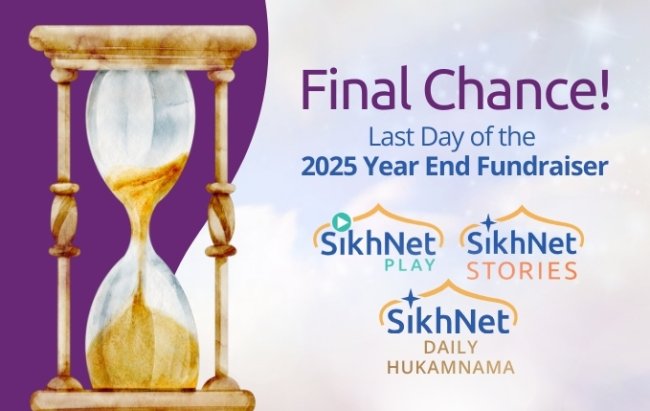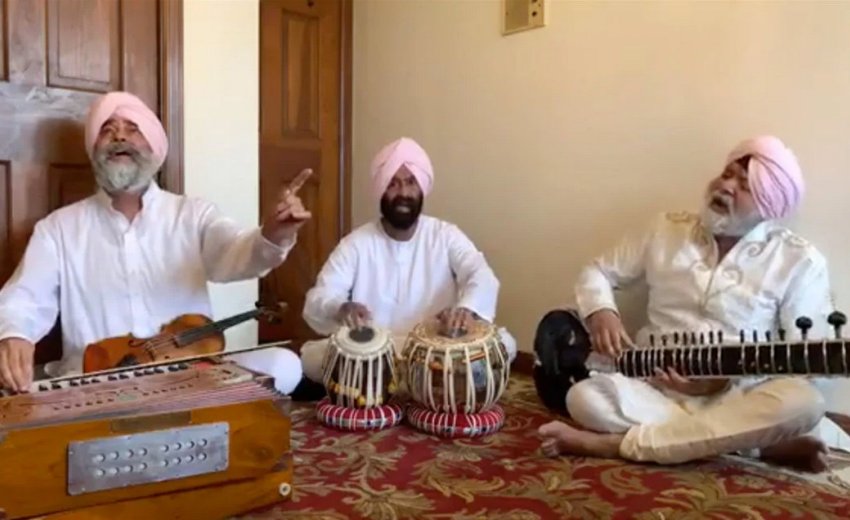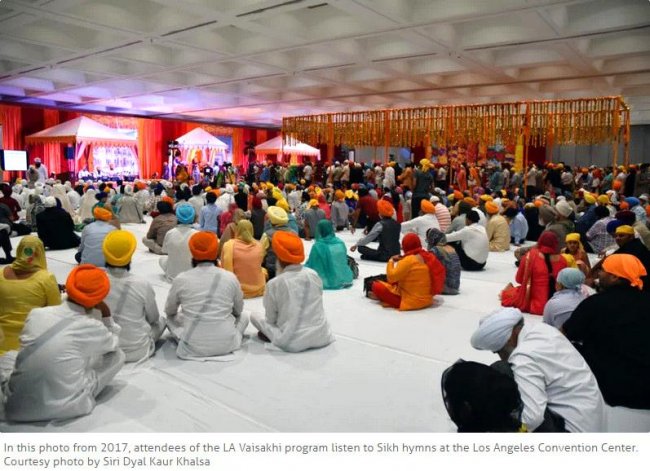LOS ANGELES (RNS) — With a grand presentation of melodious hymns, a two-mile parade in downtown Los Angeles and free food for thousands, the celebration of Vaisakhi for Sikhs in Southern California is no small occasion. But this year, the community is faced with the challenge of honoring a festive, holy day during the coronavirus pandemic.
Vaisakhi, which falls on April 13 or 14 (depending on the calendar used), is one of the most important days of the year for Sikhs. It marks the anniversary of when the tenth Guru, Sri Guru Gobind Singh Ji, created the Khalsa in 1699, formalizing Sikhism as a faith and community.
Many Sikhs feel a great sense of pride on Vaisakhi and frequently choose to take part in a ceremony called Amrit Sanchar — which is similar to baptism — on the day.
“It’s a time for people to come together to remember our history and reflect on our past together, but it's also a time for all of us to come together, whether that's at gurdwaras, whether that's through nagar kirtans or whether that's through kirtan programs,” said Rucha Kaur, the community development director at Sikh Coalition.
In LA, the occasion is usually commemorated at the city’s convention center, which is currently being used as a coronavirus treatment center.
“Literally since I was born, I've been going to the Vaisakhi celebration in the LA Convention Center pretty much every year,” said Los Angeles resident Angad Singh. He called it “one of the few times in the year where everyone, every Sikh from all parts of SoCal, come together in one place.”
Since bringing together thousands of people is no longer an option, Sikh groups in LA and around the country have been working hard to find acceptable and innovative ways to observe the holiday.
Kirtan Singh, an organizer for the LA event, said he looked to technology for a solution.
“We’re going to do it so that the raagis (those performing hymns) will be on Zoom one at a time,” Singh said. “And then we’ll broadcast it on YouTube or Facebook Live or both.”
The LA Vaisakhi program will run on Sunday (April 19).
San Jose Gurdwara, which usually puts on a large Vaisakhi event, is using Facebook Live and other livestream platforms to broadcast Sikh hymns called “kirtan." Because the gurdwara has six groups of hymn singers living there, they are able to have performances throughout the day.
“Keeping in view the restrictions on gatherings to mitigate the effects of coronavirus, we have encouraged our sangat (community) to listen to the programs from home,” organizer Narinderpal Singh said. “We expect a large number of sangat to join in through the radio to celebrate.”
The Partap Brothers, a trio of brothers in New York who sing kirtan, performed for an audience on Facebook Live on Sunday (April 12). Davinder Partap said he feels they are doing their part to help bring the Sikh community together during this difficult time.
“Just like everybody goes to gurdwara and likes to contribute something, similarly, we want to do whatever we can in celebration,” Partap said. “It's very unusual, but in these circumstances, what can we do? If we have to celebrate, we can do it at home—remembering the great contribution of Guru Gobind Singh Ji to our religion.”
Partap’s nephew Kabir said he sees this move to digital platforms as an opportunity to reach more people at once.
“Digitally, you have a bigger opportunity to spread the vision of Vaisakhi and what Sikhism stands for by going live via Instagram, Facebook, YouTube,” he said.
While technology will give Sikh Americans a sense of a Vaisakhi celebration, it won’t be perfect. Kirtan Singh said technical issues with sound will likely affect the quality of virtual events.
“The sound quality can be difficult to replicate and to produce in a way that's acceptable and pleasant to listen to,” he said. “We’re trying to make it as good as it possibly can be without having invested a tremendous amount of money into broadcasting and production.”
Angad Singh said that the inability to interact with members of the community is another downside to virtual Vaisakhi.
“Normally you only interact with your own individual communities, you know your local communities, but coming to the convention center program, you're just reminded of how much bigger the community is and how supported and how fortunate we are to be part of that community,” he said.
Attendee Asees Singh Grewall said he sees the day as a chance to bond with friends, family and even strangers who share an appreciation for the values and actions of Sri Guru Gobind Singh Ji—something he’s unlikely to experience at this year’s Vaisakhi.
“Everyone's here for, you know, a very loving purpose. You just really feel like there are no boundaries between people in the sense that we're all family. We're all one,” Grewall said. “We're just here out of love and to celebrate.”
In lieu of more traditional festivities such as live kirtan or engaging in langar (a community meal), some Sikh organizations are using easily accessible activities to bring younger Sikhs together in honor of Vaisakhi. Naindeep Singh, the executive director of the Jakara Movement, said his team has put together social media challenges with different themes for each day of the week.
“Social distancing can really have an effect on one's psyche and mental health. And so (these are) things that we can do to just say you're part of something bigger,” he said. “Your story is important to tell, you know, share your story. It just creates a vibrant community that feels connected and engaged.”
Pushpinder Kaur, the principal of San Jose Gurdwara’s Sunday school, said she is also distributing a variety of Vaisakhi-related educational materials to the nearly 700 children who attend San Jose Gurdwara’s school, so they can get an idea of what Vaisakhi means without the formal, in-person celebration.
“I have prepared a Vaisakhi book. And in that, we are talking about the history of Vaisakhi: how it started, what happened on the first Vaisakhi day, what did Guru Gobind Singh Ji do, and what is our identity,” she explained. “I gave them ideas about how they can make greeting cards for Vaisakhi. And I have written a Khalsa Kids Pledge, so they can read that or write their own poems.”
In addition to these Vaisakhi efforts, many of these leaders and groups have been working to offer resources and support to Sikhs. San Jose Gurdwara is delivering food and unemployment support to those in the community who are struggling because of COVID-19.
“We made a phone hotline for anybody who needs any kind of support,” Kaur said. “Do you need resources in terms of food? Do you need resources in terms of gloves or masks? Do you need any kind of support in terms of finances?”
Kirtan Singh said ultimately, community organizing and the virtual Vaisakhi celebration give the Sikh community a level of comfort during uncertain times.
“It's important for us to stay connected. It's important for us to keep our spirits high,” Singh said. “By creating an avenue to connect in a time when we can't get together in person has a tremendous benefit ... of just knowing that we're still together even though it's all online.”



